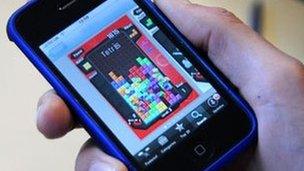Playing Tetris video game 'fixes lazy eye', doctors say
- Published

Canadian doctors say they have found an inventive way to treat lazy eye - playing the Tetris video game.
The McGill University team discovered the popular tile-matching puzzle could train both eyes to work together.
In a small study, in Current Biology with 18 adults, it worked better than conventional patching of the good eye to make the weak one work harder.
The researchers now want to test if it would be a good way to treat children with the same condition.
UK studies are already under way.
An estimated one in 50 children has lazy eye, known medically as amblyopia.
It happens when the vision in one eye does not develop properly, and is often accompanied by a squint - where the eyes do not look in the same direction.
Without treatment it can lead to a permanent loss of vision in the weak eye, which is why doctors try to intervene early.
Normally, the treatment is to cover the strong eye with a patch so that the child is forced to use their lazy eye.
The child must wear the patch for much of the day over many months, which can be frustrating and unpleasant.
Learning through play
Dr Robert Hess and colleagues in Montreal set out to investigate whether a different approach might work.
Armed with a special pair of video goggles they set up an experiment that would make both eyes work as a team.
Nine volunteers with amblyopia were asked to wear the goggles for an hour a day over the next two weeks while playing Tetris, the falling building block video game.
The goggles allowed one eye to see only the falling objects, while the other eye could see only the blocks that accumulate on the ground in the game.
For comparison, another group of nine volunteers with amblyopia wore similar goggles but had their good eye covered, and watched the whole game through only their lazy eye.
At the end of the two weeks, the group who used both eyes had more improvement in their vision than the patched group.
The researchers then let the patched group have a go at using the goggles with both eyes uncovered. Their vision then improved significantly.
Patching 'may be hindrance'
Dr Hess said the treatment could be a good alternative to patching, particularly for adults because they tend not to benefit from this anyway.
And any number of computer games could work - not just Tetris.
He said: "When we get the two eyes working together, we find the vision improves.
"It's much better than patching, much more enjoyable, it's faster and it seems to work better."
He said his research and other studies suggest amblyopia is actually a two-eye problem and that patching the good eye may hinder rather than help the weak one.
Forcing both eyes to co-operate increases the level of plasticity or adaptability in the brain and allows the weak eye to relearn how to see, he said.
- Published10 January 2012
- Published30 March 2009
- Published4 April 2012